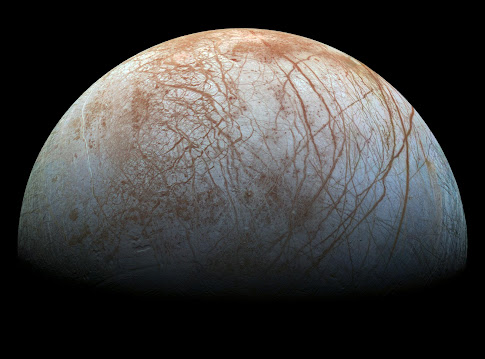Two recent studies have excited scientists
interested in looking for extraterrestrial life. Both hint at possible life on
other celestial bodies.
The one closest to home comes from
the ongoing Juno spacecraft mission studying Jupiter and its moons. Astronomers
have long known that one of Jupiter’s moons, Europa, is covered with a thick layer
of water ice, and below that icy shell lies an ocean up to 100 miles deep that holds more water than all of Earth’s oceans. The combined gravity of giant
Jupiter and Ganymede, the largest moon in our solar system, pull and squeeze
Europa, providing the energy to keep that ocean liquid.
That same gravitational tug-of-war may
create volcanic vents on the floor of Europa’s ocean. The vents constantly pump
minerals into the water, the same circumstance that many scientists believe led
to life on Earth.
The latest data from Juno indicates
that Europa generates 1000 tons of oxygen every 24 hours. That’s enough oxygen
to support one million humans. On Earth, free oxygen is produced by living
plants. The bulk of our oxygen comes from tiny algae plants in the ocean using
photosynthesis to create food and release oxygen as a byproduct.
The researchers believe that
charged particles driven by Jupiter’s strong magnetic field impact the icy
shell on Europa and break apart the water molecules to create free oxygen.
While the oxygen isn’t produced by life processes, researchers believe that
this oxygen can make its way through the icy shell to the ocean below. This
oxygen may then accelerate the evolution of any life in the ocean to create
more complex creatures, just as happened in Earth’s oceans.
Scott Bolton, Juno’s principal
investigator from the Southwest Research Institute in San Antonio, Texas, said,
“Our ability to fly close to the Galilean satellites during our extended
mission allowed us to start tackling a breadth of science, including some
unique opportunities to contribute to the investigation of Europa’s
habitability.”
The other study comes from the Webb space telescope. In 2015, NASA’s K2 mission discovered a planet dubbed K2-18b orbiting a cool, red dwarf star. K2-18b sits in the star’s habitable zone where liquid water can exist on the surface. The research study led by Nikku Madhusudhan, a professor at the University of Cambridge, identified methane and carbon dioxide in the planet's atmosphere, a strong indication that the planet could be covered in an ocean.
K2-18b is a sub-Neptune planet, one
between the size of Earth and Neptune, but, since no such planet exists in our
solar system, we don’t understand their properties very well. "Although
this kind of planet does not exist in our solar system, sub-Neptunes are the
most common type of planet known so far in the galaxy," said Subhajit
Sarkar of Cardiff University, co-author of the study. "We have obtained
the most detailed spectrum of a habitable-zone sub-Neptune to date, and this
allowed us to work out the molecules that exist in its atmosphere," Sarkar
added.
That spectrum indicated the presence of dimethyl sulfide which only living organisms can produce, at least here on Earth. Is this ocean world teeming with life? It's far too early to know if life exists there says Madhusudhan, and the researchers were quick to point out that more data is urgently needed. ''If confirmed,” he said, “it would be a huge deal and I feel a responsibility to get this right if we are making such a big claim."
Each month, I write an astronomy-related column piece for
the Oklahoman newspaper. After it is
published there, I post that same column to my blog page.
This is reprinted with permission from the Oklahoman and www.Oklahoman.com.







